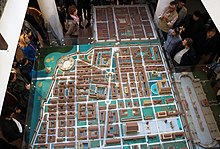
Back فيميناسيوم ARZ Виминациум Bulgarian Viminacium Czech Viminatium German Βιμινάκιο Greek Viminacium Spanish ویمیناسیوم Persian Viminacium Finnish Viminacium French Viminacium Galician
 Scale model of ancient Viminacium at the Viminacium archeological park | |
| Location | Serbia |
|---|---|
| Region | Kostolac, Braničevo District |
| Coordinates | 44°44′13″N 21°13′32″E / 44.736980°N 21.225605°E |
| Type | Fortification, mixed Roman city and legionary fort |
| Part of | Moesia Superior |
| Area | 450 hectares |
| History | |
| Founded | 1st century |
| Abandoned | 580s–620s AD |
| Site notes | |
| Condition | Ruined |
| Public access | Yes |
| Type | Archeological Site of Exceptional Importance |
| Designated | 15 March 1949 |
| Reference no. | AN 22[1] |
Viminacium[2] (also Viminatium) was a major city, military camp,[3] and the capital of the Roman province of Moesia (modern-day Serbia). Following the division of Moesia in 87, following Domitian's Dacian War, it became the capital of Moesia Superior. As of 2018, only 3-4% of the site has been explored.[4]
The site is located 6 km (3.7 mi) from the modern town of Kostolac in Eastern Serbia. The city dates back to the 1st century AD, and at its peak it is believed to have had 40,000 inhabitants,[5] making it one of the biggest cities in the Balkans of that time. It lies on the Roman road Via Militaris. Viminacium was devastated by Huns in the 5th century, but was later rebuilt by Justinian. It was completely destroyed with the arrival of Slavs in the 6th century. Today, the archaeological site occupies a total of 450 hectares (1,100 acres),[3] and contains remains of temples, streets, squares, amphitheatres, palaces, hippodromes and Roman baths.[6]
Viminacium holds the distinction of having the largest number of graves discovered in any Roman archaeological site.[7] As of 2023, 16,000 graves have been discovered.[8]
- ^ "Информациони систем непокретних културних добара".
- ^ Urbes et Loca: Moesia Superior – Moesia Inferior – Dacia
- ^ a b Darko Pejović (23 April 2018). "Srbija leži na turističkoj imperiji" [Serbia is laying on the touristic empire]. Politika (in Serbian). p. 11.
- ^ Cite error: The named reference
koracwas invoked but never defined (see the help page). - ^ Aleksandar Vasović (31 May 2018). "Serbian archaeologists find sarcophagus with two skeletons and jewellery in ancient city". Reuters.
- ^ Cite error: The named reference
B92-JADEwas invoked but never defined (see the help page). - ^ Gradimir Aničić (4 June 2018). "Ljubav nastavljena u grobnicama" [Love continued in tombs]. Politika] (in Serbian). pp. 01 & 07.
- ^ Cite error: The named reference
carnicwas invoked but never defined (see the help page).
